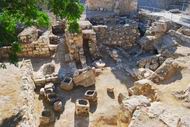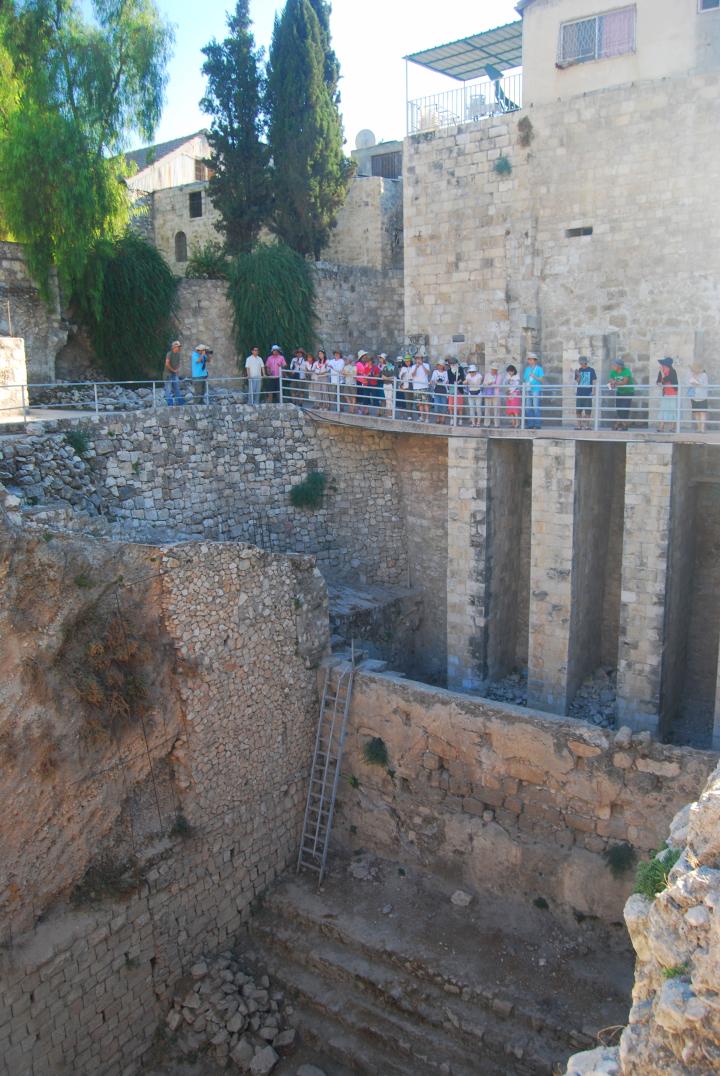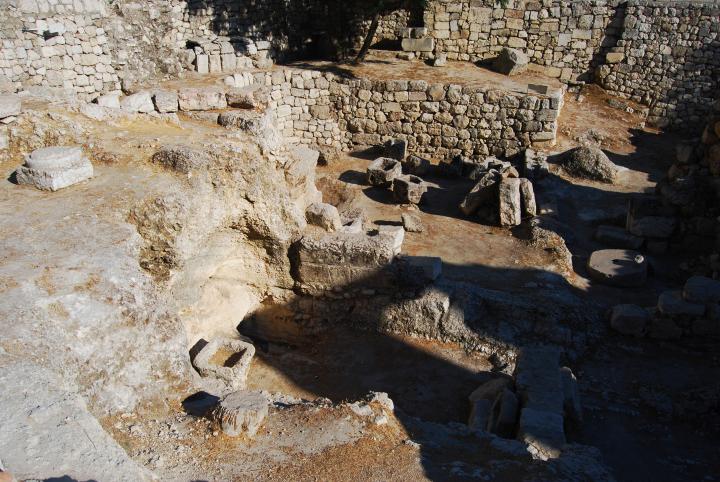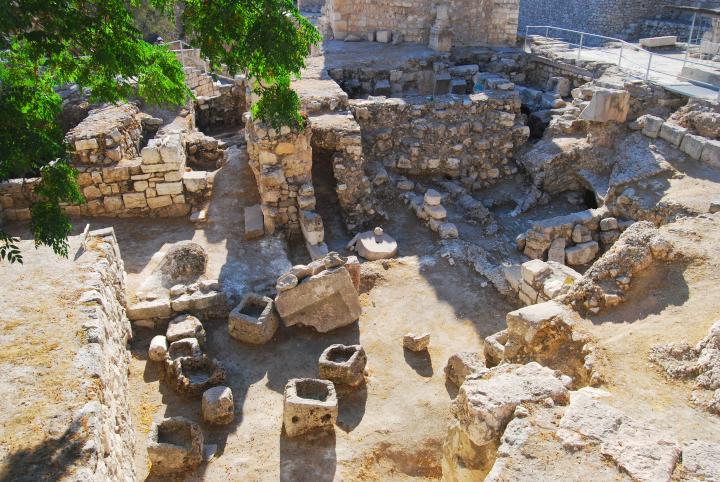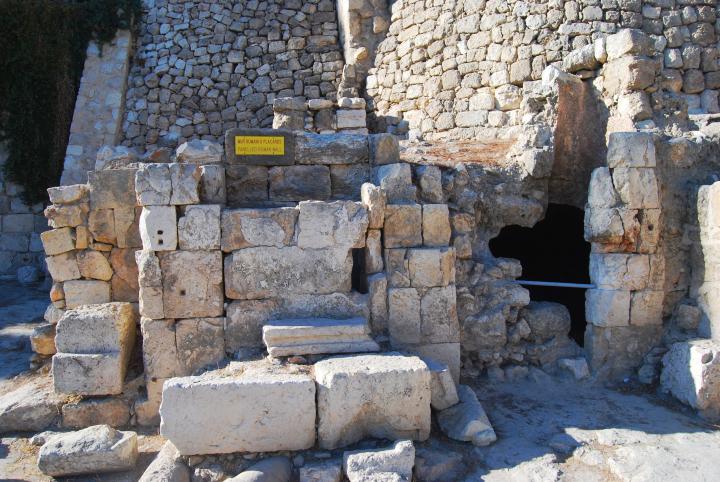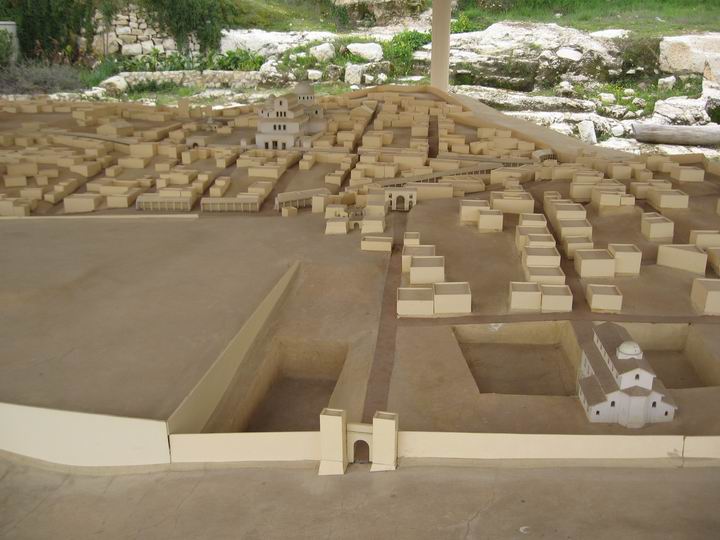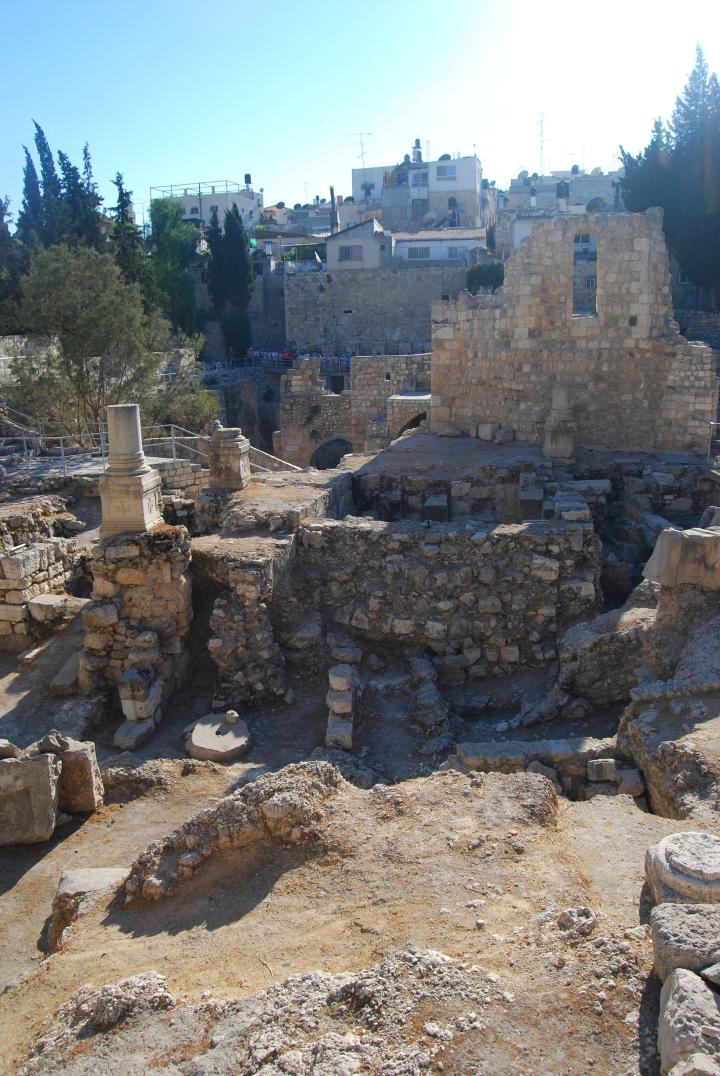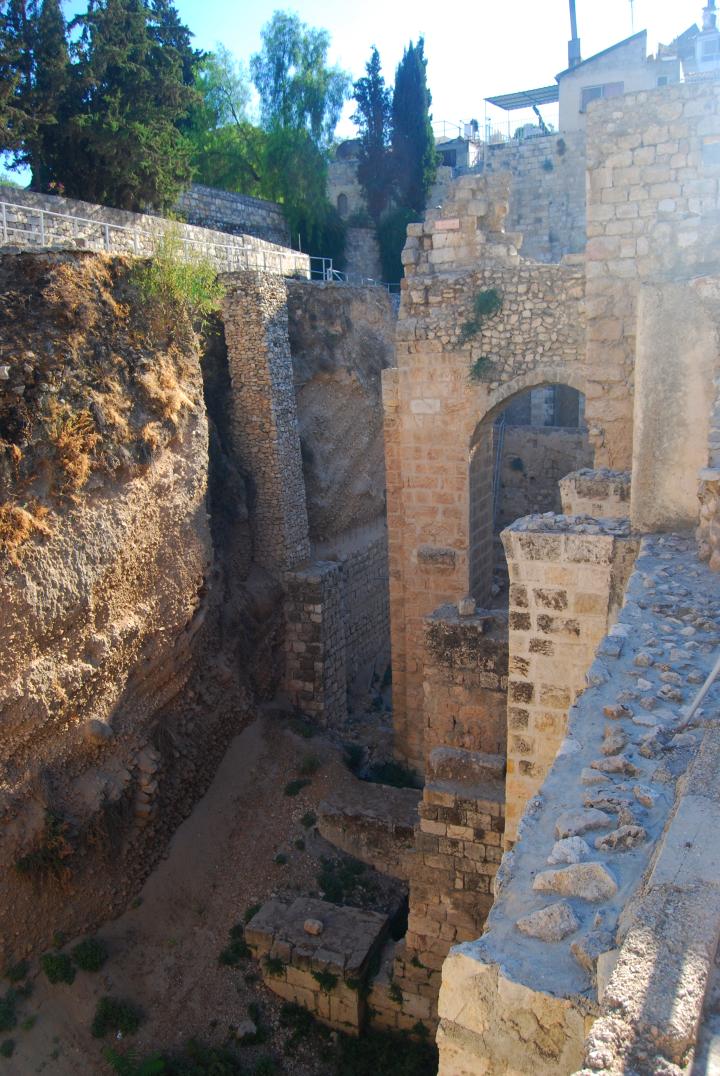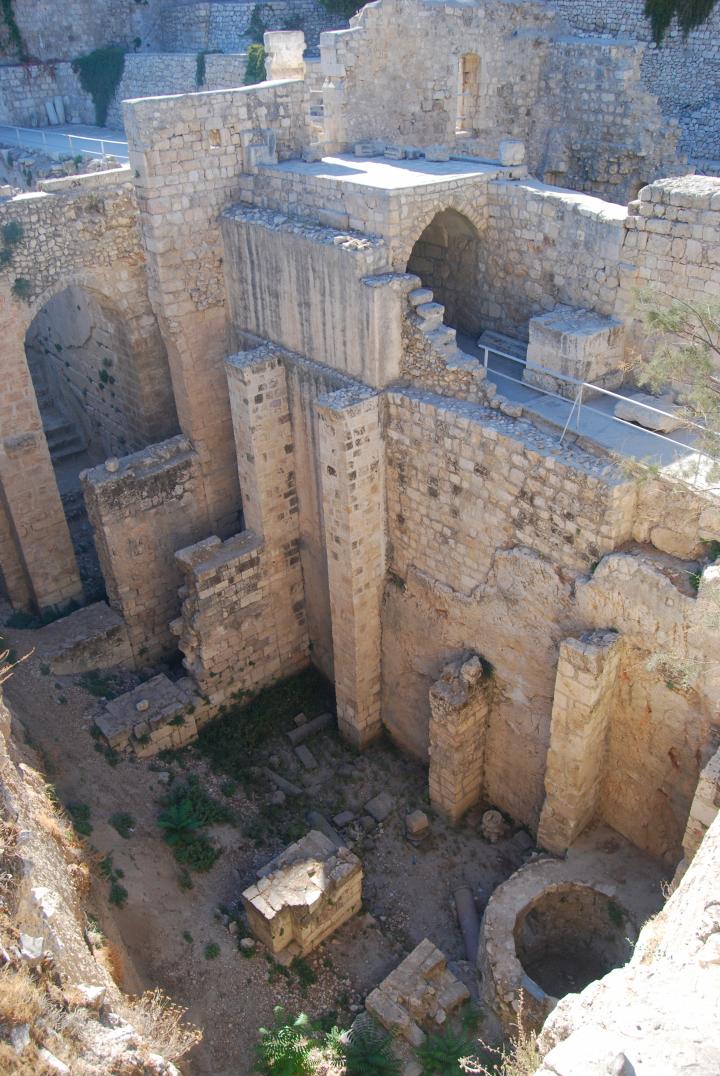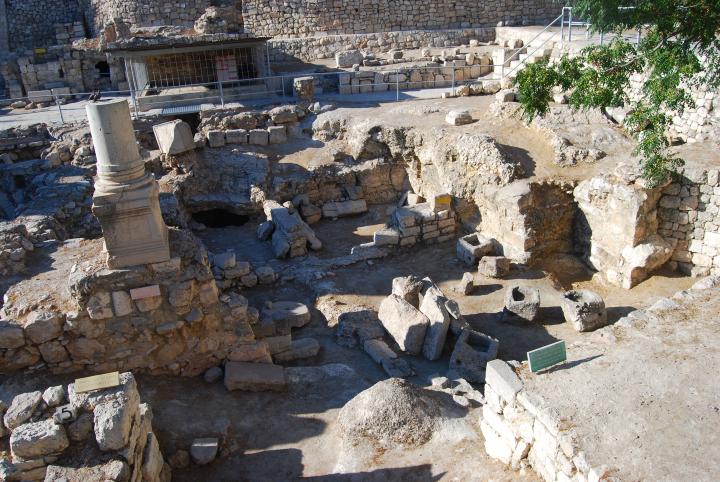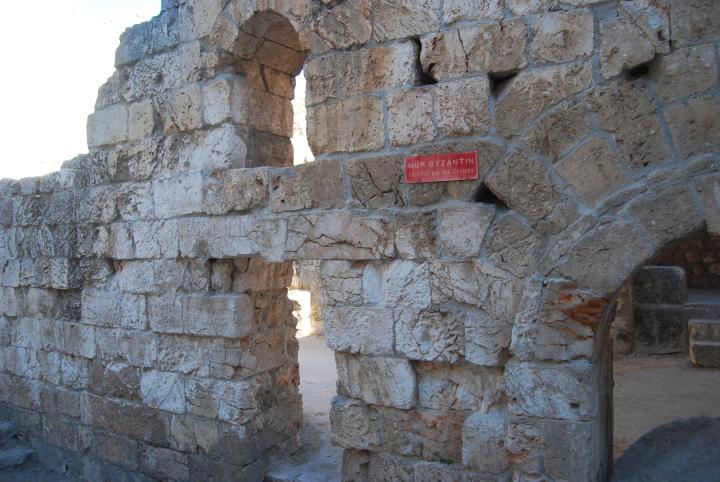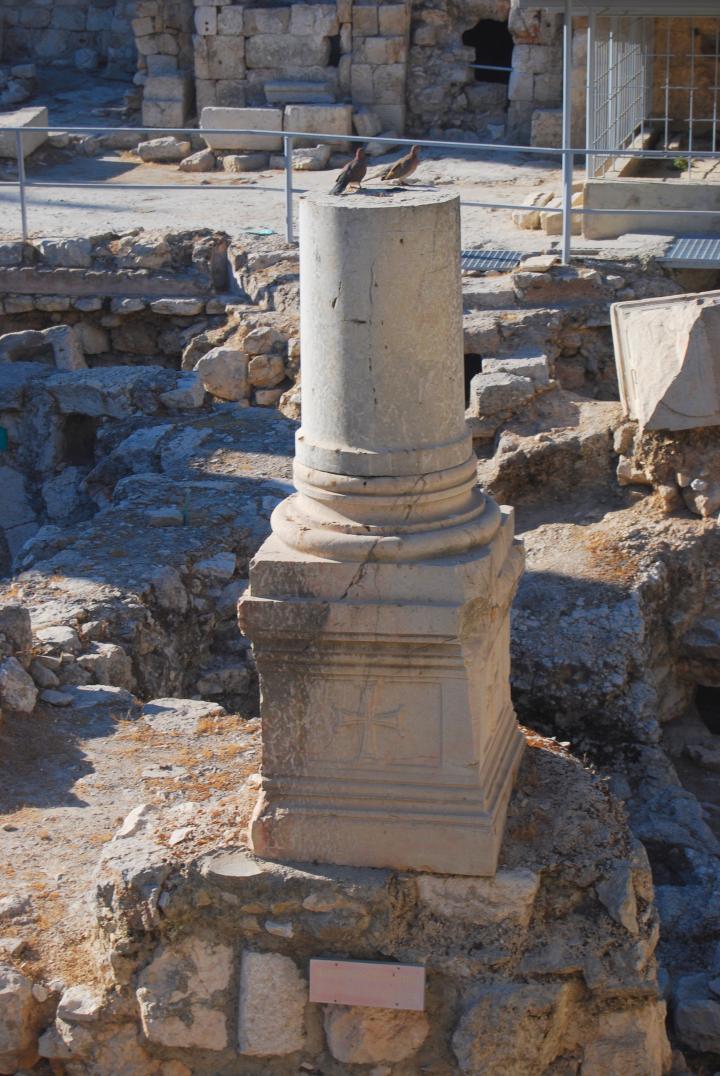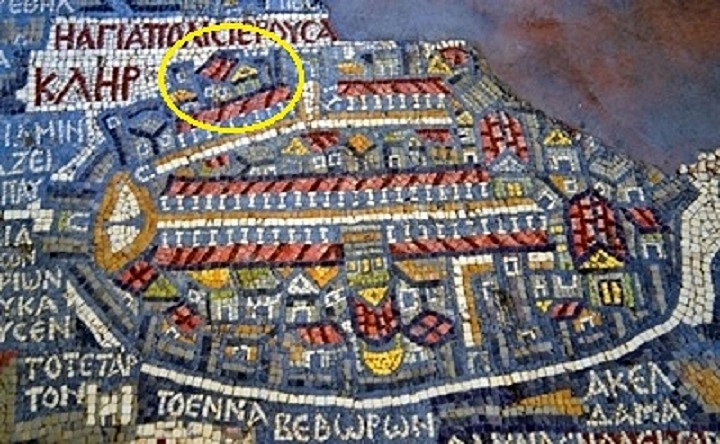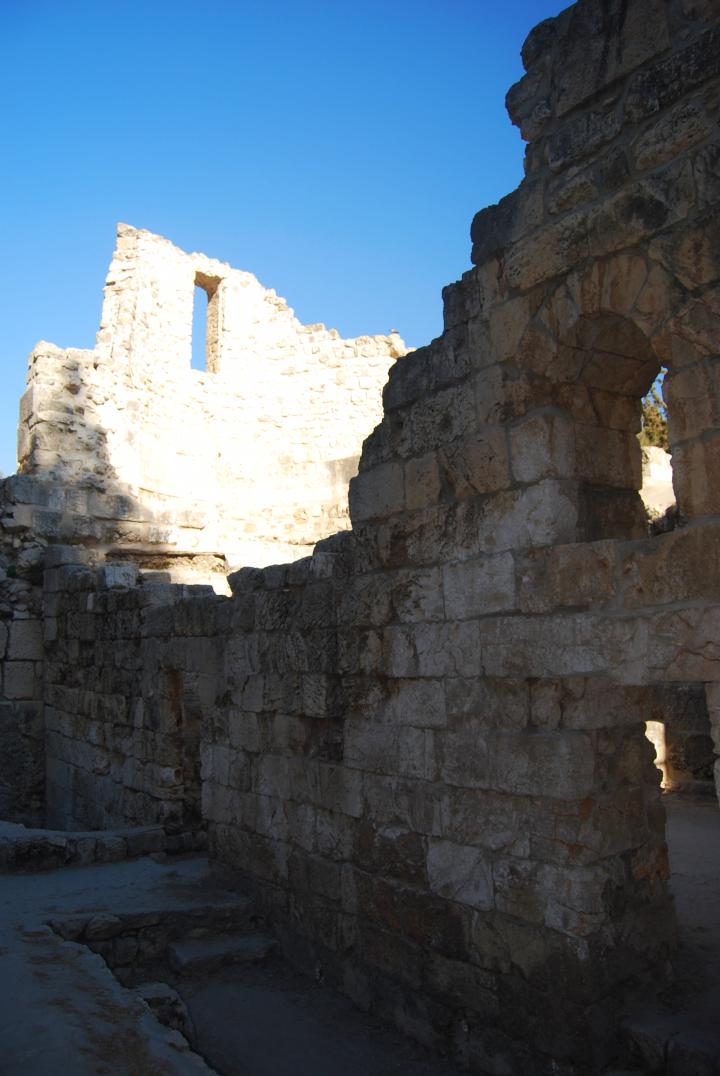Ruins of twin pools, healing center, Byzantine basilica and Crusader chapel located near St. Anna. The site of Jesus’ healing miracle, referred as the sheep market pools.
Home > Sites > Jerusalem > Bethesda
Contents:
Overview
Location
History
Photos
* General view
* Pools
* Baths
* Roman
* Byzantine
* Crusaders
* St. Anna
Biblical Refs
Etymology
Links
Overview:
Ruins of twin pools in the north side of the old city, close to the Lions gate. These pools supplied water to the temple during the times of the first and second temple (until Herod). There are references in the old testament to the “upper pool”, which may have been the name of the northern pool.
Adjacent to the pools were baths and a healing center. These baths are the site of the healing miracle of Jesus in the pools of the sheep market, which was also called “Bethesda”.
John 5:2: “Now there is at Jerusalem by the sheep market a pool, which is called in the Hebrew tongue Bethesda, having five porches”.
Later, a Byzantine basilica was built over parts of the pools. The Crusaders built a small chapel over its ruins, and later a larger Basilica nearby ( St. Anna – reviewed in a separate page).
Location:
An aerial view is seen below showing the location of the site, which is adjacent to St. Anna and the Lions’ gate.
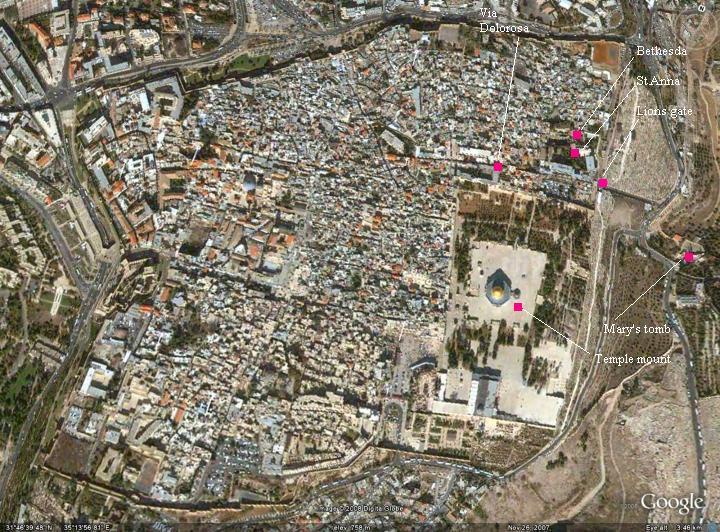
History:
- The water systems in the first temple
The Bethesda water reservoirs supplied water to the temple mount. The first pool was constructed during the first temple, based on a dam that collected rain water flowing in the valley and stored it in a natural lake. Then the waters were directed from the lake to the temple in an open channel.
There are two references in the old testament to the “upper pool”, which may have been the name of the pool.
- Second temple
In the 3rd century BC a second pool was constructed in order to increase the water capacity for the temple. The two pools were connected with a central dike that separated the pools in the center, splitting them to a northern and southern pool. Around the pools were columns. The area of the twin pools was large – 120M by 50M and 15M deep.
Later, the area of the pools was expanded and turned into a popular healing center. During the excavations held in 1956, the archaeologists unearthed traces of ruins belonging to the period in the eastern side of the two large pools. They can be seen today at the bottom of the pit.
- Roman
Herod the Great constructed a new water system to the north of Bethesda, making the twin pools obsolete. In 44 AD Herod Agrippa constructed a new wall, which blocked the water entirely, and so the pools were converted for other use.
Until the 5th century the area was used as a baths center, and its waters were famous for its healing powers, and were the source of its name – Beth-Hesda – the “house of the graceful waters”. The site was also named “sheep pool”, perhaps since the sheep that was sacrificed in the temple was washed in these waters. This use of the water to purify the sacrifice may have given the waters their perceived healing powers.
The Gospel of John tells about the miraculous healing of a paralyzed man by Jesus, which was bathing in the waters among a multitude of invalid people. The text describes the pools as “having five porches”, which were excavated at the site.
The Romans also erected, in the south-east side of the pools, a temple dedicated to Asclepius ( a Greek hero who become the Greek god of medicine and healing) or Serapis (a Greek-Egyptian God).
- Byzantine
The pools became a pilgrimage site for Christians who came to bath in its cherished waters and offer sacrifices. In the excavations some of their offerings were found in the rubble.
When Juvenal was Patriarch of Jerusalem (422-458), a large basilica (45M x 18M) was constructed in the area of the pools. It was supported by seven arches, and was built over the dike and pools. It was dedicated to “St. Mary of the Probatic” (Probatic is sheep-pool in Latin). The church also appears on the 6th century Madaba map.
- Crusaders
The Crusaders rebuilt the ruined Byzantine church after conquering the city in 1099, and added a chapel above it. It became a monastery.
Later, in 1140, they added a grand basilica in an area adjacent and south-east to the chapel – which they dedicated to St. Anna.
A 19th century photo shows the state of the pool before the area was excavated.

Bethesda pool – 1860-1880 – Photos of the Library of Congress
- Modern times
The baths and pools were excavated in 1956. They are open to the public at visiting hours of St. Anna.
Photos:
(a) General View:
An eastern view of Bethesda is seen below, with 5 levels: second temple on the lower side (in the foreground), Roman above it, Byzantine in the center level, Crusaders on top most level, and modern level in the background.
Click on the photos to view in higher resolution…
The photos below are arranged in the chronological order, from earliest to latest levels. Since the different periods are highly mixed together, and the excavations left only a section of each layer, it may be difficult to visualize the order of the different layers.
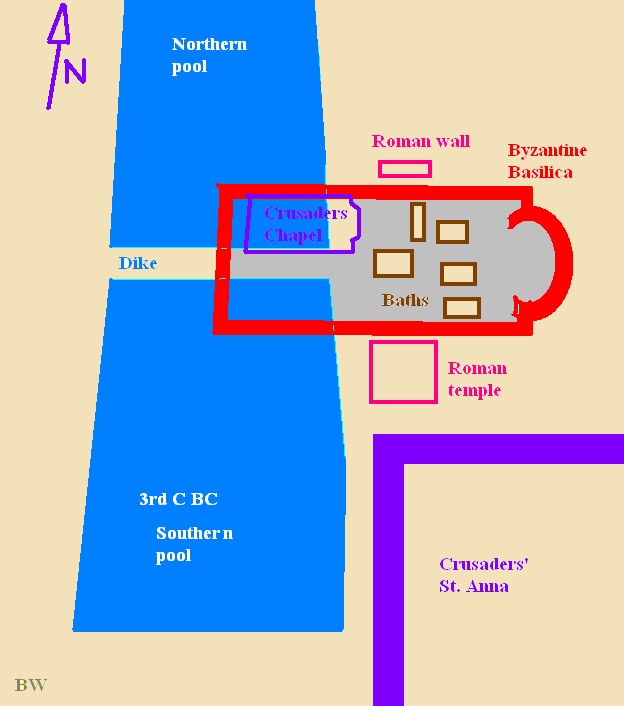
(b) Pools:
The photo below shows the western side of the southern pool, which was built in the 3rd C BC. You can see how deep is the cavity. This pool added capacity to the water reservoir which collected the rain water. The area of the twin pools was large – 120M by 50M and 15M deep.
The pool extended to the south, and its waters were directed towards the temple mount in an open channel. That section is covered by a garden, and you can view the south-eastern side from a staircase that is located in the court yard of St. Anna.
(c) Baths:
Between 150 BC and 70 AD a popular healing center was developed east of the twin pools. The central water channel is seen below. It brought the waters from the north pool into a cistern which is seen in the bottom left side, which was used to fill up the baths around the cistern.
The baths and grottoes are seen below. They were used for medicinal and religious purposes, mostly by invalids which were barred from the temple.
Another view of the baths is seen below, taken from the south-eastern side. In this scene are stone baths, water channels, vaulted rooms and grottoes which were part of the healing center. Here, Jesus met the sick people bathing in the waters, and cured a paralytic (John 5:3: “In these lay a great multitude of impotent folk, of blind, halt, withered, waiting for the moving of the water”).
(d) Roman health center:
The Romans added, between 200 AD to 400 AD, several fine buildings in and around the popular healing center. In the photo below is a plastered wall on the north side of the ruins.
The Romans also erected, in the south-east side of the pools, a temple dedicated to Asclepius ( a Greek hero who become the Greek god of medicine and healing) or Serapis (a Greek-Egyptian God).
(e) Byzantine Basilica:
During the middle of the 5th century AD a large Byzantine basilica (45M x 18M) was constructed on the area between the twin pools, extending eastwards where the apse was located. It was dedicated to “St. Mary of the Probatic” ( Probatic is Latin for sheep-pool, based on the Biblical text which referred the pools as the sheep market).
A model of the Byzantine city is on display in the Gallicantu church, reconstructing how the north-east side of Jerusalem used to look in the 5th century AD. In the photo below you can see the Byzantine basilica standing between the twin pools of Bethesda (the left pool is the southern one).
The city today looks different from the Byzantine city, since many layers have been built over it. The archaeologists uncovered the top layers, and parts of the Byzantine structures can be seen.
The photo below shows the excavations of the western side of the Byzantine basilica. The two columns bases on the left were part of the structure, located in its center. Beyond the columns is a deep cavity, which is part of the northern pool, and the church stood over the pool supported by seven arches.
On the right side, higher above the Byzantine level, is a trace of the smaller Crusader chapel, which was built 700 years later.
The south-western side of the Byzantine church was located in the south pool, seen below. It was supported by seven arches, three of them are visible. The tall base of one of the arches is seen in the center.
Another view of the seven arches, that support the Basilica and extend into the southern pool, is seen below.
In the photo below you can see traces of the structures from three periods: Byzantine (top level), late Roman (middle level), and second-temple (lower level).
The upper level are remains of the south-east side of the Byzantine basilica, with three of its column bases visible.
On the middle level, where smaller stones are seen just under the columns, are baths and grottoes which were part of the Roman health center. On the far left side a Roman temple was excavated which was dedicated to the Greek God of health. It is hidden under the pavement.
On the lower level are traces of the area of the pools which may have been in operation during the times of Jesus, called the Bethesda pools.
In the north side of the basilica, behind the metal cage seen in the upper side in the photo below, is a section of a Byzantine mosaic floor. In a lower level, on the right side, are vaulted rooms, baths and grottoes belonging to the earlier period, which was was concealed by the Byzantine structure.
A section of the northern walls of the Basilica are seen below.
A detail of one of the Byzantine column bases is seen below.
It is interesting to find that “St. Mary of the Probatic” appears on an ancient map of the Holy Land from the 6th century AD. Jerusalem is illustrated in a 54 x 93cm section of the Madaba Mosaic map, which was discovered in 1884 in a Byzantine church in Madaba, Jordan. This ancient map, laid out in the 6th century AD, shows the map of the Holy Land, with dozens of illustrated sites. Jerusalem is seen in a perspective aerial view from the west, and reveals several of the highlights of the city, including St. Mary of the Probatic (marked with a yellow circle) and St. Stephen’s gate (today – the Lions’ gate).
(f) Crusaders chapel:
The Byzantine Basilica was destroyed by the Arab rulers in 1010. When the Crusaders captured Jerusalem in 1099 they found the Byzantine Basilica in ruins. Rather than repairing it, they built a small 20 x 10m chapel on top of the ruins. It can be seen on the top-left side of the the photo below, above the Byzantine basilica which is seen on the right side.
(g) Crusaders St. Anna Basilica:
The church of St. Anna is located near the excavations of Bethesda, and was built by the Crusaders at about 1140. The photo below shows an eastern section of Bethesda pools, and the large church behind it, with a view of its northern side. St Anna is reviewed in a separate page.
Biblical References:
John 5 1-9:
This text tells about how Jesus cured a sick man in the pools of Bethesda, which is a pool near the sheep market. The text is followed by a debate of whether healing is allowed during the Sabbath, which did not conform to the religious Jewish practices at that time.
“After this there was a feast of the Jews; and Jesus went up to Jerusalem. Now there is at Jerusalem by the sheep market a pool, which is called in the Hebrew tongue Bethesda, having five porches. In these lay a great multitude of impotent folk, of blind, halt, withered, waiting for the moving of the water. For an angel went down at a certain season into the pool, and troubled the water: whosoever then first after the troubling of the water stepped in was made whole of whatsoever disease he had.
And a certain man was there, which had an infirmity thirty and eight years. When Jesus saw him lie, and knew that he had been now a long time in that case, he saith unto him, Wilt thou be made whole? The impotent man answered him, Sir, I have no man, when the water is troubled, to put me into the pool: but while I am coming, another steppeth down before me. Jesus saith unto him, Rise, take up thy bed, and walk. And immediately the man was made whole, and took up his bed, and walked: and on the same day was the sabbath”.
Isaiah 7,3:
This text refers to the “upper pool”, perhaps the name of the Bethesda pools. In this text, King Ahaz prepared for war, and inspected the water supply in view of a possible siege.
“Then said the LORD unto Isaiah, Go forth now to meet Ahaz, thou, and Shearjashub thy son, at the end of the conduit of the upper pool in the highway of the fuller’s field;”
2 Kings 18,17:
This text also refers to the “upper pool”.
“And the king of Assyria sent Tartan and Rabsaris and Rabshakeh from Lachish to king Hezekiah with a great host against Jerusalem. And they went up and came to Jerusalem. And when they were come up, they came and stood by the conduit of the upper pool, which is in the highway of the fuller’s field.”
Etymology (behind the name):
- Bethesda – From Hebrew: Beth (house) and Hesda (kindness, charity, excellent, excel). The name may have been based on the quality of the waters in these pools, which their top-class quality granted favors to those who bathed in it. Perhaps, the quality attributed to these waters came from their use in the temple.
- Probatic – Latin: sheep-pool, based on the Biblical text which referred the pools as the sheep market.
- Piscina Probatica – Latin – sheep pool.
Links:
- Footsteps of Jesus – This pictorial presentation is arranged by BibleWalks staff. The event in Bethesda is event #27.
BibleWalks.com – walk with us through the sites of the Holy Land
St. Anna<—previous Jerusalem site–<<< All Sites >>>—> Flagellation
This page was last updated on Dec 26, 2020 (Add LOC photo)
Sponsored links:
